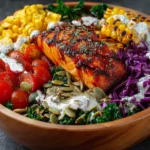Corn dogs are a quintessential carnival treat that brings to mind fun fairs, summer festivals, and county fairs. The crispy cornmeal crust, wrapped around a juicy hot dog, makes for a snack that’s as nostalgic as it is delicious. While commonly associated with food trucks and fairgrounds, corn dogs can be made at home easily, and they are incredibly satisfying to prepare. In this guide, we’ll explore everything you need to make perfect homemade corn dogs, including batter tips, frying methods, and creative variations.
Ingredients (Makes 8-10 Corn Dogs)
For the Batter:
- 1 cup yellow cornmeal
- 1 cup all-purpose flour
- 1/4 cup granulated sugar
- 1 tablespoon baking powder
- 1/2 teaspoon salt
- 1/4 teaspoon paprika (optional, for extra flavor)
- 1 large egg
- 1 cup milk (plus extra if needed for consistency)
- 2 tablespoons honey (optional, for added sweetness)
For the Corn Dogs:
- 8-10 hot dogs
- 8-10 wooden skewers
- 4 cups vegetable oil (for frying)
Directions:
- Prepare the Hot Dogs:
- Pat the hot dogs dry with a paper towel to ensure the batter adheres well.
- Insert a wooden skewer into each hot dog, leaving enough stick exposed for easy handling. Set them aside.
- Make the Batter:
- In a large bowl, whisk together the cornmeal, flour, sugar, baking powder, salt, and paprika.
- In a separate bowl, whisk together the egg, milk, and honey (if using).
- Gradually mix the wet ingredients into the dry ingredients, stirring until smooth. If the batter feels too thick, add a splash of milk.
- Heat the Oil:
- Pour the vegetable oil into a large, deep skillet or pot. Heat it to 350°F (175°C) using a kitchen thermometer to maintain the right temperature.
- Dip and Fry:
- Transfer the batter into a tall glass or jar for easy dipping.
- Dip each hot dog into the batter, ensuring it’s fully coated. Let any excess batter drip off.
- Carefully place the battered hot dog into the hot oil. Fry 2-3 corn dogs at a time to avoid overcrowding.
- Cook for 3-4 minutes, turning occasionally until golden brown and crispy.
- Remove the corn dogs from the oil and place them on a plate lined with paper towels to drain excess oil.
- Serve and Enjoy:
- Serve the corn dogs hot with your favorite dipping sauces, such as mustard, ketchup, honey mustard, spicy mayo, barbecue sauce, or cheese sauce.
Nutrients (Approximate per Corn Dog)
- Calories: 270-350
- Fat: 18g
- Carbs: 25g
- Protein: 7g
- Sugar: 3g
Corn dogs are one of those iconic comfort foods that evoke memories of childhood, carnivals, and fairgrounds. Whether you’re indulging in one at a summer festival or preparing them in your own kitchen, there’s something irresistibly satisfying about the combination of a juicy hot dog enveloped in a crispy, golden cornmeal batter. The hot oil sizzle, the satisfying crunch, and the flavor-packed bite all come together to create a treat that is nostalgic and timeless. While the corn dog is a staple at many food trucks and amusement parks, it is also one of the easiest and most fun dishes to recreate at home. In this article, we’ll dive deep into the history, variations, and tips for making homemade corn dogs that rival those found at your favorite fair.
The History of Corn Dogs
Corn dogs have a long and somewhat debated history, but most agree that they were first introduced in the United States in the 1940s. Although several vendors claim to be the originators, the most widely accepted story is that they were created by German immigrants who wanted to combine the American love for hot dogs with the European tradition of battering and frying food. Cornmeal batter, which is hearty and crunchy, made an excellent coating for the hot dog, and soon corn dogs became a mainstay at state fairs and carnivals across the country.
The classic corn dog is often credited to two men, Neil and Carl Foster, who patented their version of the recipe in 1942. According to their claim, they began selling their corn dogs at the Texas State Fair, which helped popularize the treat. Over time, the fried, skewered hot dog became synonymous with state fairs, carnivals, and summer fun, providing a quick, portable, and satisfying snack for fairgoers.
The Art of Making Homemade Corn Dogs
Making corn dogs at home is easier than it may seem, and the process can be customized to suit personal tastes and preferences. By preparing your own batter and choosing the right hot dogs, you can create a snack that’s both delicious and unique. Below are a few important considerations and tips for making homemade corn dogs that turn out crispy, golden, and flavorful every time.
The Corn Dog Batter: A Critical Element
The key to a perfect corn dog is the batter. The batter must be thick enough to adhere to the hot dog while maintaining a light, crispy texture after frying. A traditional corn dog batter consists of cornmeal, flour, sugar, baking powder, salt, and egg. The cornmeal gives the batter its signature crunch, while the flour helps provide structure and moisture.
For a light and fluffy batter, make sure to mix the dry ingredients well before incorporating the wet ingredients. You want the batter to be thick enough to coat the hot dog generously but still smooth enough to dip the dog without clumping. Adding a little milk or water will help adjust the consistency of the batter. If you prefer a sweeter batter, consider adding a small amount of honey or maple syrup, which enhances the flavor and adds a touch of caramelization when fried.
Hot Dogs: The Heart of the Corn Dog
While the batter is important, the hot dog itself is the star of the show. Choosing the right hot dog can elevate your corn dog experience. Traditional corn dogs use beef or pork hot dogs, but you can experiment with different varieties such as turkey, chicken, or even vegetarian options for a twist. Be sure to select hot dogs that are firm enough to hold their shape when skewered and fried. Thicker hot dogs tend to work best as they don’t shrink as much during cooking, which ensures that your corn dog maintains its structure.
Frying the Corn Dogs: Achieving the Perfect Crunch
Frying the corn dogs correctly is crucial for a golden, crispy exterior. The oil must be hot enough—around 350°F (175°C)—to cook the batter quickly without making it greasy. If the oil is too cool, the batter will absorb more oil and become soggy. A deep-frying thermometer is helpful for maintaining the right temperature, but if you don’t have one, you can test the oil by dropping a small amount of batter into it. If it sizzles and rises to the surface immediately, the oil is ready.
When frying, don’t overcrowd the pan. Frying too many corn dogs at once can lower the oil temperature and result in uneven cooking. It’s best to fry in small batches, turning each corn dog carefully until it reaches a golden brown color. The cooking time is typically around 3-4 minutes per batch, but this may vary depending on the size of your hot dogs and the thickness of the batter.
Creative Variations on the Classic Corn Dog
While the traditional corn dog is a beloved favorite, there are many creative ways to put a spin on this iconic treat. For example, consider adding spices such as chili powder, garlic powder, or smoked paprika to the batter for an extra kick. If you prefer a more savory flavor, try incorporating shredded cheese into the batter or wrapping the hot dog in a slice of bacon before battering and frying.
For a more gourmet approach, swap out the regular hot dog for a sausage, bratwurst, or even a veggie dog. These alternatives can bring a new depth of flavor and make the corn dog more suitable for different dietary preferences. You can also experiment with different batters—such as using a beer batter for an added richness and complexity. Some home cooks even opt for stuffed corn dogs, where cheese or other fillings are encased in the batter along with the hot dog.
Serving Your Corn Dogs
Once your corn dogs are perfectly fried, it’s time to serve them. Traditionally, corn dogs are enjoyed with a side of mustard or ketchup, but you can get creative with the dipping sauces. Try pairing your corn dog with barbecue sauce, ranch dressing, spicy mayo, or even a tangy honey mustard for a new flavor experience.
If you want to make your corn dogs a complete meal, serve them with a side of fries or a fresh salad. Corn dogs are also great for kids’ parties, backyard barbecues, or casual gatherings with friends and family. They are portable, easy to eat, and fun for everyone.
The Benefits of Homemade Corn Dogs
While store-bought or fairground corn dogs can be convenient, homemade versions offer several advantages. Not only can you control the ingredients and flavors, but you also have the opportunity to make healthier choices. By frying at home, you can use healthier oils or opt for air frying if you want to cut down on calories. Homemade corn dogs are also fresher and more customizable, allowing you to experiment with different ingredients and seasonings to match your tastes.
Making corn dogs from scratch is a fun and rewarding experience. Whether you’re making them for a special occasion or simply craving a delicious snack, there’s no denying the satisfaction of biting into a hot, crispy corn dog you’ve made yourself.
Conclusion
Corn dogs are a simple yet satisfying treat that holds a special place in American food culture. From their origins at state fairs to their status as a beloved snack, these battered and fried hot dogs continue to bring joy to people of all ages. With a few basic ingredients and a little know-how, you can recreate this classic carnival food in the comfort of your own kitchen. Experiment with different variations, flavors, and dipping sauces, and you’ll have a dish that’s both fun to make and fun to eat. Whether you’re making them for a party or just as an afternoon snack, homemade corn dogs are sure to become a favorite in your culinary repertoire.






